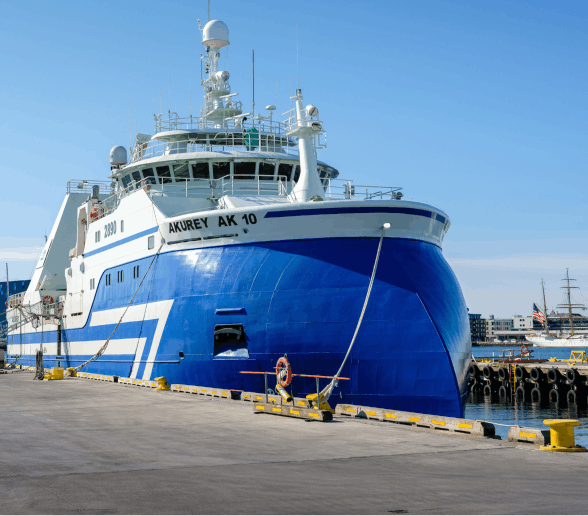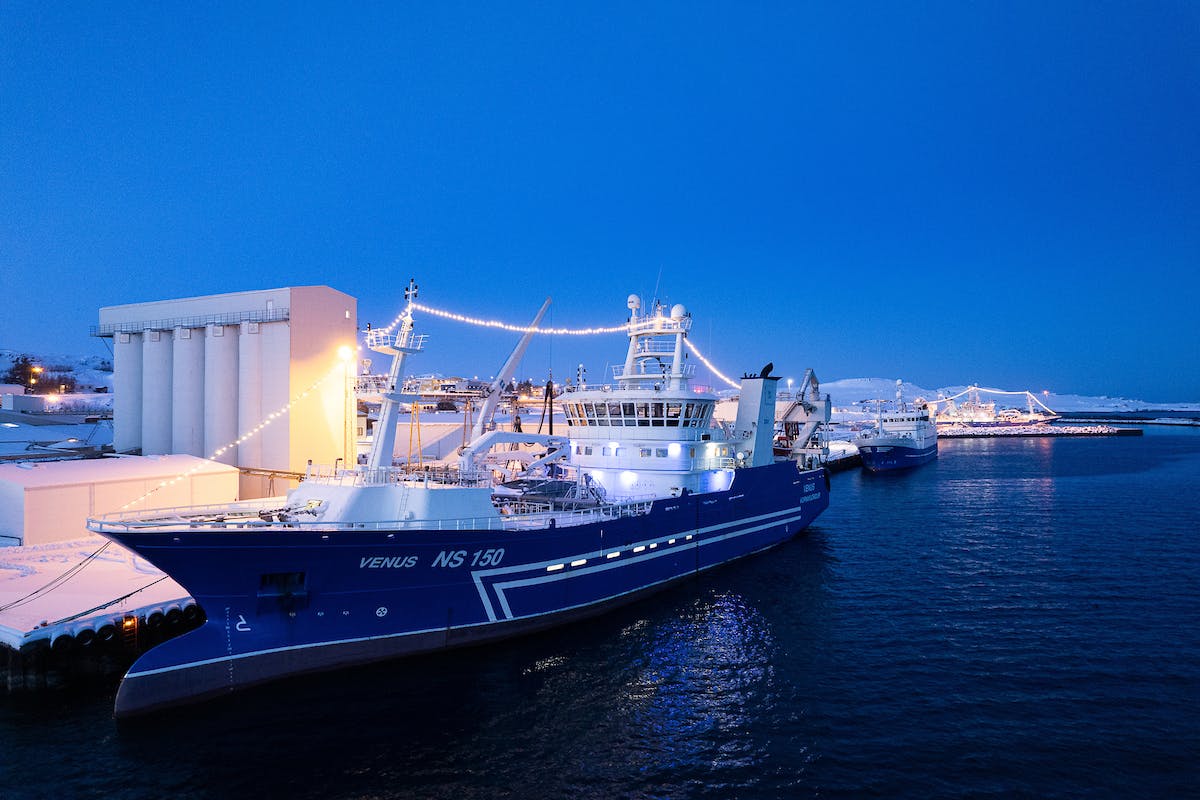Brim hf.
Annual and Sustainability Report 2021

The company’s extensive investments in high-tech processing equipment in recent months have resulted in increased production of more valuable products that were sold in markets that pay high prices for quality products.

CEO’s Address
Brim showed its strength over the last year. Brim’s staff weathered the storm and showed perseverance for the second year in a row during a difficult year due to the COVID-19 pandemic. Brim’s operations were successful and resulted in a good performance for the company. All over the company – along the entire value chain, in fishing, processing, marketing and sales of products – the situation was responded to quickly and safely, and the staff of Brim and its subsidiaries deserve heartfelt thanks for their good performance. Once again, it became clear how important it is for the company to have control over the entire value chain, as this provides an overview and increased flexibility, which is crucial when circumstances change out in the world, where our customers and markets are.
The fishing went well during the year, and sales of our products in foreign markets were successful. The company’s extensive investments in high-tech processing equipment in recent months have resulted in increased production of more valuable products that were sold in markets that pay high prices for quality products. Investments in new vessels and catch quotas in recent years are also paying off more and more in the operations. Brim’s sales amounted to EUR 387.9 million, compared to EUR 292.4 million the previous year, and profit for the year was EUR 75.2 million, compared to EUR 29.4 million in 2020. The company’s performance, excluding interest payments and interest income, tax payments and depreciation, or so-called EBITDA, was EUR 94.2 million, and as a percentage of total income, it amounted to 24%. The company’s total assets were EUR 795.5 million, and Brim’s equity ratio was 50% at the end of the year.
For the fifth year in a row, Brim’s Annual Report gives a detailed account of the company’s activities other than financial, with sustainability, ecological footprint, human resources and social responsibility being the most important. In this way, management, shareholders and the general public can see what the company’s contribution is to the general progress and reforms that are aimed for with the United Nations’ Global Goals, but the company is determined to work towards them.
During the year, as before, Brim emphasised innovation and social responsibility. This year, Brim registered blue and green bonds. By issuing the bonds, the company finances projects that promote sustainability, have a positive impact on the environment and are related to the sea and water. According to our information, Brim is the first fisheries company in the world to issue blue bonds. Brim was named Social Media Celebrity of the Year 2021 at the Business Festival which was held late last year, for its extensive support of sports and youth work, accident prevention and rescue work, cultural work, innovation and education. I would especially like to mention Brim’s support of the Icelandic language, i.a. by supporting the Icelandic Literary Society, offering Icelandic language courses for non-native speakers of Icelandic and by launching an effort to remind people that seafaring and fishing are intertwined with Icelandic culture and language, as can be clearly seen in numerous proverbs and sayings that point in that direction. It is my opinion that Brim can improve its working conditions and competitiveness by strengthening and supporting the local community, increasing sustainability and respecting its entire surroundings.
We at Brim celebrate a good fishing year. We have all hands on deck and are optimistic about the future, headed for smooth sailing.
Investments
Brim is a financially strong company with a lot of equity, which is largely profit reserves. The company’s owners can dispose of profits after taxes either to shareholders as dividends or retained in the company for further growth and to increase the company’s ability to invest. It is the company’s policy to divide profits after taxes each year, with one share going to shareholders as dividends and the other share being retained by the company for investments and growth of the company. In the last 30 years, about 60% of Brim’s profits have been retained for investments and strengthening the company’s operations. This has resulted in Brim’s financial strength, so that in recent years, the company has invested in new construction of trawlers and pelagic vessels, acquisitions of fisheries companies such as Ögurvík and Kambur and renewal of high-tech processing equipment in Norðurgarður in Reykjavík and acquisitions of sales and marketing companies in Asia and Eastern Europe. All these investments were made without too much leverage. I believe that this is a good ownership policy which shows that the owners of the company want the company to be financially strong and independent vis-à-vis credit institutions.
Last year, however, investments were fewer than usual, and one of the reasons is that Brim’s growth in the Icelandic fisheries industry is restricted. In fact, Brim had to reduce its catch quotas last year due to the calculation of total cod equivalents. Following an unusual allocation of capelin fishing quotas, Brim had to sell its catch quotas, which the company had all the capacity and ability to fish and process. Brim’s catch limit for each fish species is within limits, but when estimating the company’s total cod equivalents, the company exceeded the 12% maximum.
Below is a figure depicting the total cod equivalents in Icelandic waters from 2015 to the present day. It shows that until 2021, the total cod equivalents were around 430–440 thousand tonnes per year, while in 2022, the total will be 603 thousand cod-equivalent tonnes. The proportion of capelin in total cod equivalents increases in one year from 0% to 37.4%. The coefficient of equivalence of capelin rose sharply as capelin was processed into more valuable products last season, but this was possible because companies such as Brim have invested in better vessels and processing equipment that increases the value of capelin caught. As a result, Brim’s calculated cod equivalents exceed 12% of the total cod equivalents, which is the statutory maximum.
As can be seen in the figure, the value of capelin in calculated cod equivalents has become significantly higher than that of cod. An article in the Fisheries Management Act on cod-equivalent algorithms creates uncertainty and is unpredictable, and it is important that the government reviews this opaque calculation rule.
Advantage Difference
Concentration in fishing and production of seafood in international markets is increasing steadily. The main competitors of Icelandic fisheries companies are constantly growing and strengthening, while the growth of Icelandic fisheries companies is being restricted.
Iceland is in 17th place among the largest catch nations in the world, but at the same time, no Icelandic fisheries company comes close to one hundred of the largest fisheries companies in the world. The reasons are, e.g. the objectives of the Fisheries Management Act that each fisheries company can only have 12% of the total cod equivalents in Icelandic waters. If this methodology continues to be used in the calculation of cod equivalents, as has been done so far, it will weaken the competitive position of Icelandic fisheries companies in foreign markets, and it is therefore important that the method is rethought.
Apart from the maximum catch limit for companies in individual species and the above-mentioned calculation rule for cod equivalents, which narrows the growth potential of companies in the fisheries sector, there is also a very narrow definition and interpretation by competition authorities of how competition law applies to the Icelandic fisheries sector. When the Icelandic competitive market is examined and how the Competition Authority has approved mergers of companies there, companies often have well over 30 to 40% market share, while in the fisheries sector, the maximum is 12%. This limit will impede development and innovation in the fisheries sector and weaken the competitive position of Icelandic fisheries companies in foreign markets. One of the main purposes of competition is to ensure the rights of consumers in their domestic market, which does not apply when almost all production of Icelandic fisheries companies is sold on foreign international markets. As stated above, very strict laws apply to the maximum share of each fishing company in fishing quotas. But then, competition law in the interpretation of the Competition Authority in Iceland also prevents co-operation and mergers of companies in the fisheries sector that are allowed in our competitor countries within the EEA and the EU. This is despite the fact that laws from Parliament on fisheries management ensure the distribution of catch limits and thus competition for fishing quotas far beyond what happens in other sectors and in other countries. But as is well known, the market share of companies in the Icelandic consumer market, such as in retail and oil distribution, is often well over 30%, but no Icelandic fisheries company is close to that dominant position.
When looking at the advantage differences in the fisheries sector, there is also reason to highlight the different conditions that fishing vessel operators have in comparison to the growing support for the production of marine products in aquaculture. There are few aquaculture companies in Iceland with sea farming licenses. Their growth has been very great in recent years, and the production capacity has multiplied from 2015 to the present day. The legislature has not imposed size restrictions on these companies as on fishing companies, and there is no ban on foreign investment in aquaculture as in the fisheries industry. It is important to closely monitor developments in these two marine production sectors, i.e. wild fish catches and aquaculture, in the coming years and to see how these companies develop. Both companies fishing for wild fish and those engaged in aquaculture aim to manage the entire value chain for consumers, as developments abroad give clear indications that the final will of the consumer is to know where the product comes from. The consumer also wants to know the carbon footprint of the product and what impact it has had on the communities it comes from.
Reliability
Brim takes its social role seriously and assumes responsibility and communication with all stakeholders based on reliability. In recent years, the company has received various awards in the field of environmental and social issues that have filled the company’s staff with pride. However, it is not possible to ignore that the fisheries sector as an industry is facing widespread suspicion and mistrust. It is important to work to create trust in the industry. With a thorough and regular settlement of all aspects of Brim’s activities, where transparent and reliable information is clearly stated, the company is contributing to creating trust.
Companies such as Brim, however, are only one side of the Icelandic fishing industry. The government and public institutions are the other side. Parliament, the Ministry of Fisheries, the Marine Research Institute, the Directorate of Fisheries, the Exchange Rate Bureau, the Competition Authority, the Iceland Transport Authority and the Director of Internal Revenue are institutions that shape the framework of the fisheries sector in Iceland. All of these parties could, with increased transparency, simpler and clearer regulations, guidelines and greater predictability and easier access to information, make a significant contribution to reducing suspicion and increasing trust in the industry as a whole. In these times of information chaos and fake news, it is more important than ever that all those involved in this most important industry in the country contribute to promoting an informed debate about the industry and increase trust in all those involved.
In the fisheries sector, there is plenty to argue about, without facts being debated. They must always be out in the open. Increased transparency and improved access to information as well as simple and clear regulations are, in my opinion, the key to us as a society being able to discuss and reach an agreement regarding the organisation of the fisheries sector at any given time. We need to reach an agreement on a structure that will ensure the nation a strong and sustainable fishing industry for the foreseeable future and a strong position in the international market for seafood, where our performance will ultimately be decided. There is little point in fishing and processing fish if there are no consumers in the wider world who want to buy and eat our good fish.

About the Annual and Sustainability Report
For the fifth year in a row, Brim reports on the non-financial aspects of its operations and for the second time with a joint Annual and Sustainability Report.
All information in the report is in accordance with the best knowledge we have at the time of writing, but it is not an exhaustive assessment of all the impact that Brim has on the environment, society and/or the economy. The report is not audited by a third party, but EFLA has reviewed the presentation and information on environmental aspects.
Information on the non-financial aspects of the operation is prepared in accordance with the GTI Standard (Global Reporting Initiative GRI100-400) and Nasdaq’s UFS guidelines.